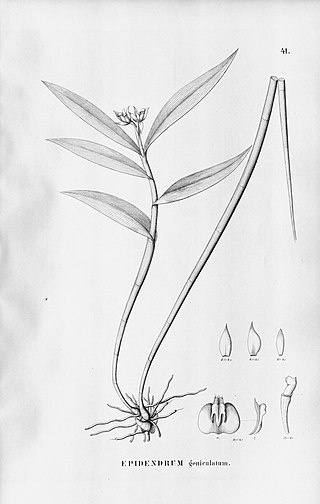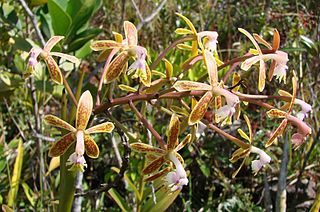
Epidendrum radicans is a species of orchid. Common names include ground-rooting epidendrum, fire-star orchid, rainbow orchid, and reed-stem epidendrum. It is a common roadside weed at middle elevations in Central America. It is a crucifix orchid, often confused with many other members of the section Schistochila, including E. calanthe, E. cinnabarinum, E. denticulatum, E. erectum, E. fulgens, E. ibaguense, E. imatophyllum, E. incisum, E. schomburgkii, E. secundum, and E. xanthinum, among others. The diagnostic characteristic of E. radicans is its tendency to sprout roots all along the length of the stem; other crucifix orchids only produce roots near the base. Additionally, E. radicans flowers are resupinate, unlike the members of the Epidendrum secundum complex, E. fulgens, and many other crucifix orchids. E. radicans also differs from E. secundum by bearing no nectar in the flower.

Epidendrum secundum, one of the crucifix orchids, is a poorly understood reed stemmed species, which Dressler (1989) describes as "the Epidendrum secundum complex." According to Dressler, there are dozens of varieties, some of which appear to deserve species rank. Arditti and Ghani note that E. secundum has the distinction of bearing the longest seeds known in the Orchidaceae, 6.0 mm long. By comparison, the seeds of E. ibaguense are only 2.9 mm long.

Epidendrum denticulatum, one of the crucifix orchids, is a reed stemmed species which, at least in herbarium specimens, is frequently confused with E. secundum Jacq.

Epidendrum fulgens is a crucifix orchid native to Brazil. Like E. secundum, with which it has been found to hybridize in habitats disturbed by human activity, E. fulgens flowers are non-resupinate and are born in a congested raceme at the end of a long spike. Like all crucifix orchids, the lip is adnate to the column and bears three lobes, producing the effect of a cross. Like E. cinnabarinum, E. denticulatum, and E. puniceoluteum, E. fulgens grows in the litoral restinga habitat.

Epidendrum flexuosum, a reed-stemmed Epidendrum common at mid-altitudes in Central America, is a species of orchid commonly called Epidendrum imatophyllum. It grows exposed to intense sunlight in the forest canopy, particularly on Guava species. E. flexuosum bears non-resupinate lavender flowers on a congested raceme at the end of a long peduncle.

Epidendrum geniculatum is a deciduous, sympodial, caespitose orchid native to the Brazilian states of Espirito Santo and Rio de Janeiro, at elevations from 300 – 800 m.

Epidendrum armeniacum is an epiphytic species of reed-stemmed Epidendrum orchid that grows wild in Bolivia, Brazil, Ecuador, and Peru, at altitudes of 1–2 km.

Epidendrum blepharistes is a species of orchid in the genus Epidendrum native to Bolivia, Colombia, Costa Rica, Ecuador, Peru, and Venezuela.

Epidendrum cristatumRuiz & Pav. (1789) is a species of orchid in the genus Epidendrum which is known to grow both terrestrially and epiphytically at altitudes near 1 km in the Neotropics from Mexico and Belize down through Brazil, as well as Trinidad.

Epidendrum macrocarpum, widely known as Epidendrum schomburgkii, is a species of orchid in the genus Epidendrum, and the largest-flowering crucifix orchid species. Reichenbach thought that E. fulgens and E. schomburgkii var. confluens were both synonyms for this species.

Epidendrum ibaguense is a species of epiphytic orchid of the genus Epidendrum which occurs in Trinidad, French Guiana, Venezuela, Colombia and Northern Brazil.

Epidendrum rigidum is an epiphytic reed-stemmed Epidendrum orchid common throughout the Neotropical lowlands, below 600 m (2,000 ft).
Epidendrum dendrobii is a terrestrial species of reed-stemmed Epidendrum of the Orchidaceae which grows on steep slopes in tropical montane cloud forests of Cochabamba, Bolivia and Venezuela at altitudes near 2.6 km.

Epidendrum sect. SchistochilaRchb.f. (1861) is a section of the subgenus E. subg. AmphiglottiumLindl. (1841) of the Genus Epidendrum of the Orchidaceae. E. sect. Schistochila differs from the section E. sect. Holochila in that the species in E. sect. Holochila have undivided lips; the species in E. sect. Schistochila have lobate lips. The species in both E. sect. Schistochila and E. sect. Holochila have racemose inflorescences, unlike those in E. sect. Polycladia, which have truly paniculate inflorescences. Like the other sections of E. subg. Amphiglottium, the members of E. sect. Schistochila are sympodial orchids bearing thin stems with alternate leaves, a long peduncle covered with thin, imbricating sheathes, and a lip adnate to the very end of the column.
Epidendrum miserrimum is a small sympodial epiphytic orchid native to northern South America, the West Indies and Central America at altitudes as low as 0.7 km and as high as 1.2 km.

Epidendrum sculptum is a sympodial, epiphytic reed-stemmed orchid native to the Neotropics from Chiapas Mexico to Brazil, at altitudes ranging from near sea level to 0.5 km.
Epidendrum tridens is a terrestrial orchid closely allied to E. nocturnum, of which it has often been considered a variety or synonym. For example, Reichenbach 1861 lists Epidendrum tridens(Poepp. & Endl.) Cogn. (1898) as a synonym of Epidendrum nocturnum and Epidendrum nocturnum var. latifoliumLindl. (1837) as a distinguishable variety of Epidendrum nocturnum.

Epidendrum calanthum is a terrestrial reed-stemmed Epidendrum orchid from the montane Tropical rainforest of Bolivia, Colombia, Ecuador, Peru, Venezuela, and the West Indies.
Epidendrum lanipes is an epiphytic sympodial orchid with spindle-shaped stems native to the montane tropical rainforest of Bolivia, Colombia, Ecuador, and Peru at altitudes ranging from 0.8 to 1.4 km.
Epidendrum cochlidium is a neotropical orchid which can grow both terrestrially and epiphytically in Peru and Venezuela at altitudes ranging from 1.2 km to 2.9 km.















